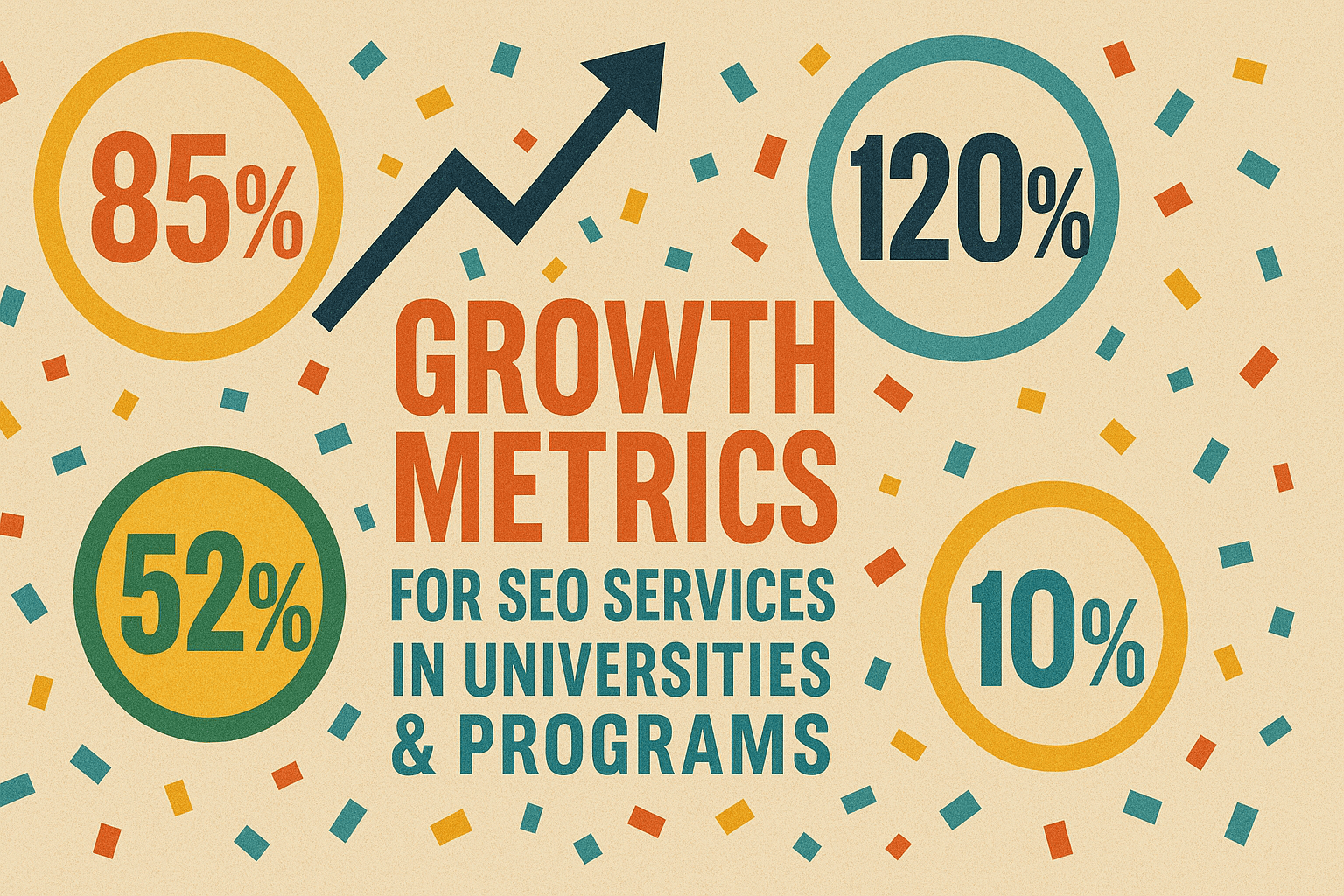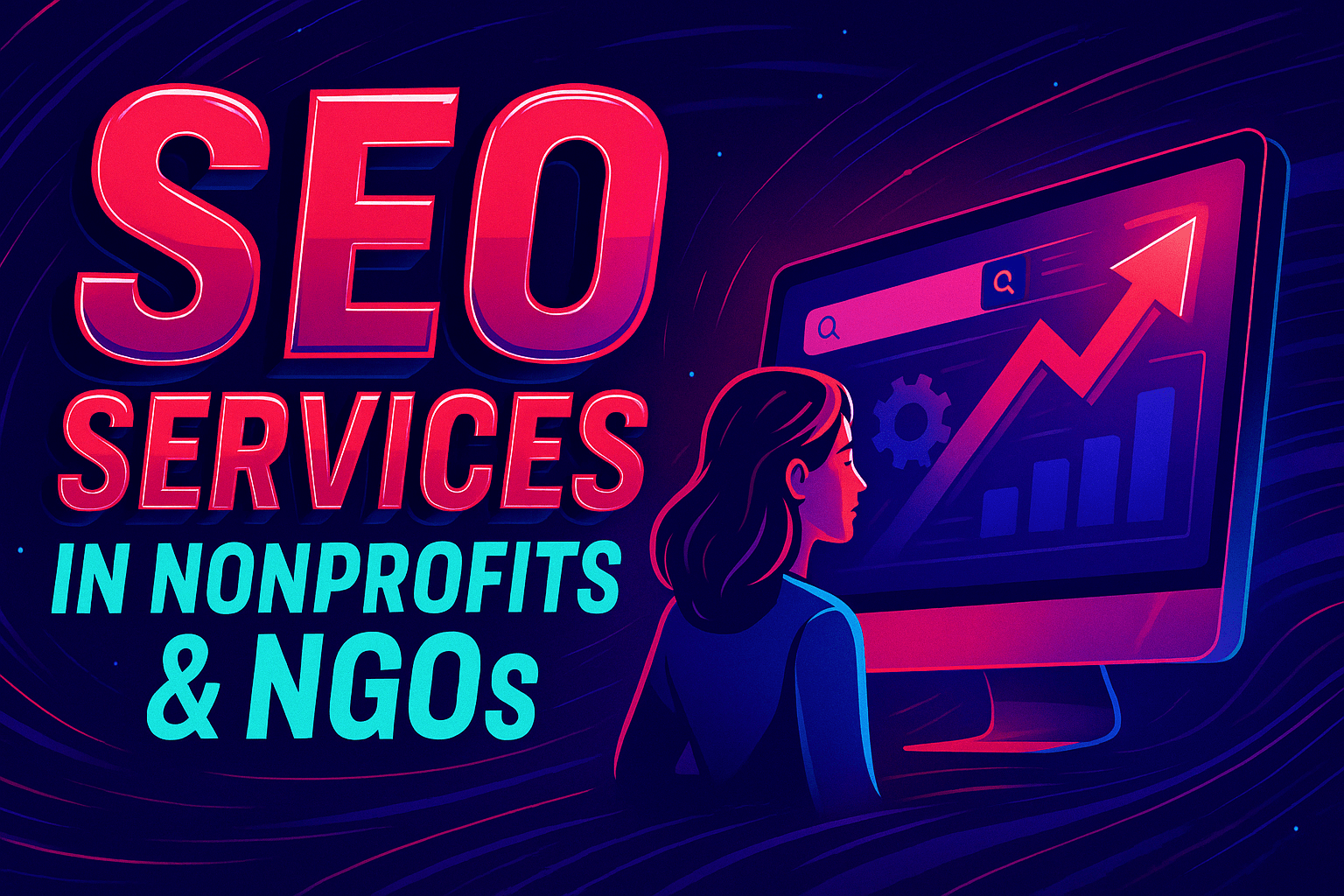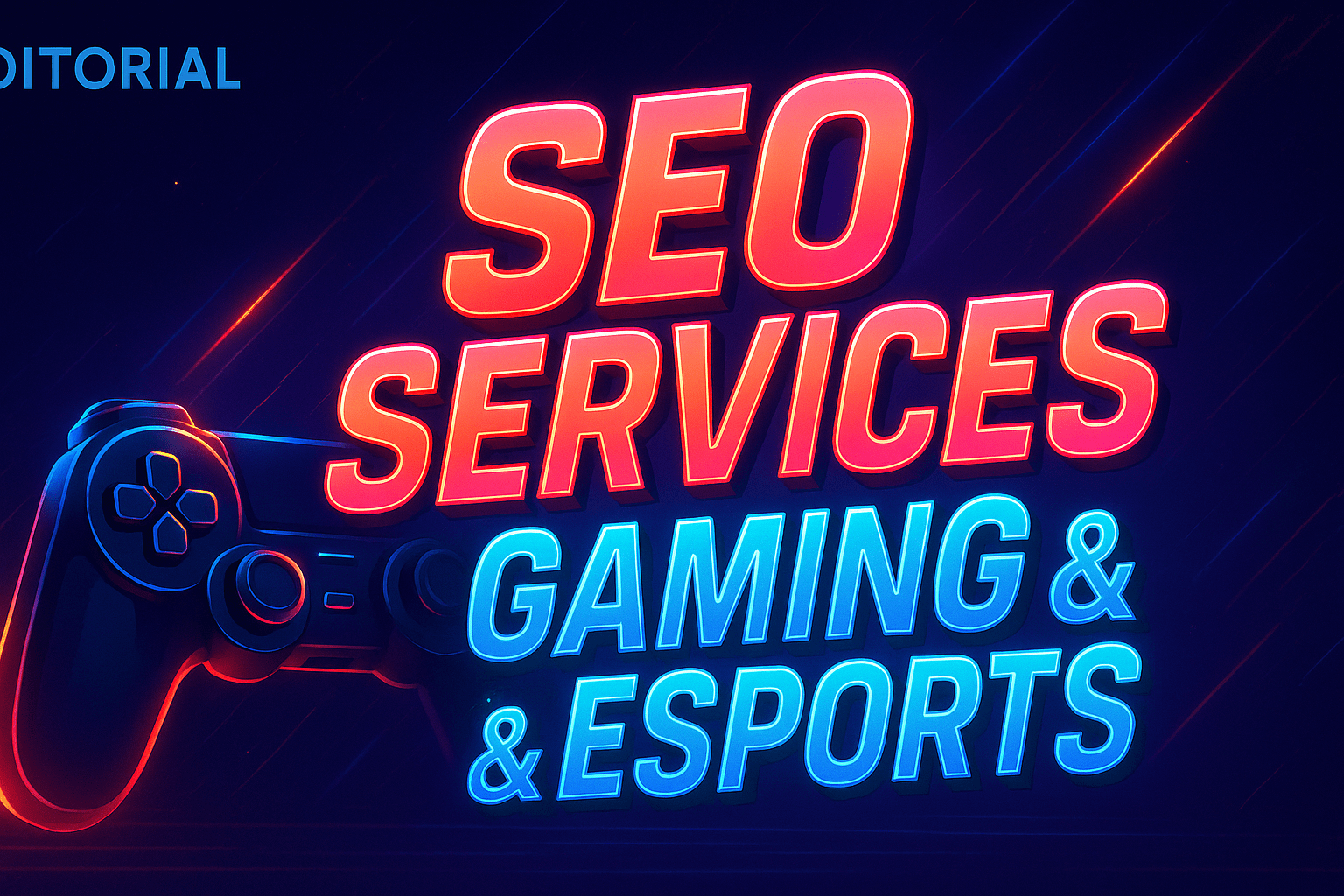SEO Services for Universities & Programs: Complete 2026 Implementation Guide
by Design Delulu Editorial · October 23, 2025

Smart, fast, and measurable. Here's how seo services helps universities & programs win.
Higher education institutions face unprecedented digital competition. Prospective students conduct an average of 157 searches before selecting a university, yet most academic programs remain invisible during critical decision-making moments. Traditional marketing channels deliver diminishing returns while cost-per-acquisition continues climbing—making organic search visibility not just valuable, but essential for sustainable enrollment growth.
Universities that master SEO fundamentals gain compounding advantages: lower acquisition costs, higher-quality applicants, and predictable enrollment pipelines. The institutions winning in 2026 aren't outspending competitors—they're out-strategizing them with search intent mapping, technical optimization, and content architectures designed for how modern students actually research academic programs. This guide reveals the exact frameworks, implementation timelines, and measurement systems that drive measurable results.

Why Universities Need Specialized SEO Services in 2026
The higher education search landscape has fundamentally shifted. Prospective students no longer start their journey with institution names—they search for outcomes, career paths, and program comparisons. Queries like "best data science programs for career changers" or "affordable MBA programs with high ROI" dominate early-stage research, yet most university websites remain optimized for branded searches that occur only after decisions have narrowed.
Generic SEO approaches fail in this environment because they don't account for extended consideration cycles, multiple stakeholder involvement (students, parents, advisors), and the unique trust signals that influence academic decisions. Universities need search strategies that map to enrollment funnels, not e-commerce conversion paths.
The Modern Student Search Journey
Today's prospective students move through four distinct search phases:
- Discovery Phase: Broad exploratory searches about careers, fields of study, and educational pathways ("is a master's degree worth it for software engineering")
- Research Phase: Program-specific comparisons and requirement investigations ("online vs campus MBA programs comparison")
- Evaluation Phase: Institution-level research including outcomes data, costs, and student experiences ("University of X computer science placement rates")
- Decision Phase: Application requirements, deadlines, and final comparison searches ("how to choose between University X and University Y")
Each phase demands different content types, technical implementations, and conversion pathways. Universities that only optimize for branded searches miss 70-80% of the decision journey, ceding early influence to competitors and third-party ranking sites.
What Makes University SEO Different
Academic institutions face unique search challenges that require specialized approaches:
- Seasonal Search Patterns: Query volumes fluctuate dramatically around application deadlines, creating narrow windows for maximum impact
- Complex Site Architectures: Multiple departments, programs, and content owners create technical SEO nightmares with duplicate content, competing pages, and broken internal linking
- Stakeholder Coordination: Marketing, admissions, academic departments, and IT teams must align on priorities and execution
- Compliance Requirements: Accessibility standards, data privacy regulations, and accreditation guidelines constrain implementation options
- Long Conversion Cycles: 12-18 month consideration periods require sustained visibility and nurture content
Success requires balancing brand authority with program-specific relevance, technical excellence with content velocity, and immediate wins with long-term compounding growth.
Core Components of Effective University SEO Services
Comprehensive SEO for higher education institutions rests on four integrated pillars. Each component amplifies the others—technical optimization enables content performance, while strategic keyword mapping guides both technical priorities and content investment.
1. Search Intent Mapping & Keyword Strategy
Effective university SEO begins with understanding what prospective students actually search for and when those searches occur in their decision journey. This goes far beyond basic keyword research.
Strategic keyword mapping includes:
- Journey Stage Alignment: Categorizing keywords by funnel position (awareness, consideration, decision) and mapping them to appropriate content types and conversion goals
- Program-Level Keyword Clusters: Building comprehensive keyword families around each academic program, including degree-specific, career-focused, and comparison terms
- Search Intent Classification: Identifying informational, navigational, commercial, and transactional intent patterns to guide content creation and page optimization
- Competitive Gap Analysis: Discovering high-value keywords where competitors rank but your institution doesn't, revealing quick-win opportunities
- Seasonal Pattern Recognition: Understanding how search volumes shift throughout the academic calendar to time content launches and optimization sprints
The output is a prioritized keyword map that connects search demand to business objectives, ensuring every optimization effort drives toward enrollment goals rather than vanity metrics.
2. Technical SEO & Site Architecture
University websites accumulate years of technical debt—legacy systems, departmental silos, and inconsistent implementations create crawling and indexation problems that suppress organic visibility regardless of content quality.
Critical technical optimizations include:
- Crawl Budget Optimization: Eliminating crawl traps, managing duplicate content, and ensuring search engines efficiently discover high-priority program pages
- Site Architecture Redesign: Creating logical, scalable URL structures that reflect program hierarchies and support internal linking strategies
- Schema Markup Implementation: Deploying structured data for courses, programs, events, and organizations to enhance search result visibility and eligibility for rich snippets
- Page Speed Optimization: Addressing render-blocking resources, image optimization, and server response times to meet Core Web Vitals thresholds
- Mobile Experience Enhancement: Ensuring flawless mobile functionality since 65%+ of early-stage research occurs on mobile devices
- Internal Linking Framework: Establishing systematic linking patterns that distribute authority, guide user journeys, and reinforce topical relevance
These technical foundations unlock the full potential of content investments, often delivering 20-40% visibility increases without adding a single new page.

3. Content Strategy & Hub Architecture
Universities generate enormous content volumes but rarely with strategic purpose. Effective SEO content strategies transform scattered pages into interconnected hub systems that dominate topical authority and capture traffic across the entire student journey.
Strategic content frameworks include:
- Pillar Page Development: Creating comprehensive, authoritative pages for core programs and topics that serve as definitive resources and link destinations
- Cluster Content Systems: Building networks of supporting content pieces that explore subtopics in depth while linking back to pillar pages
- Comparison & Alternative Pages: Addressing competitive queries directly rather than allowing third-party sites to control the narrative
- Career Outcome Content: Highlighting employment data, alumni success stories, and industry partnerships that align with career-focused search queries
- Student Experience Assets: Creating authentic, searchable content about campus life, student perspectives, and program experiences
- FAQ & Support Content: Answering common application, financial aid, and program-specific questions that represent high-intent, conversion-ready searches
Each content piece serves dual purposes: addressing specific search queries while reinforcing broader topical authority. The result is compound growth where new content amplifies existing pages and vice versa.
4. Measurement & Optimization Systems
SEO success in higher education requires connecting organic search performance to enrollment outcomes. Vanity metrics like rankings and traffic matter only if they correlate with application volume and student quality.
Effective measurement frameworks track:
- Revenue-Aligned KPIs: Inquiry form submissions, application starts, program-specific leads, and eventual enrollment attribution
- Visibility Metrics: Impression share, average position, and ranking distributions for priority keyword segments
- Engagement Signals: Time on page, scroll depth, and interaction rates that indicate content effectiveness
- Technical Health Indicators: Crawl stats, indexation rates, Core Web Vitals performance, and structured data validation
- Competitive Benchmarking: Share of voice comparisons, keyword gap monitoring, and relative ranking performance
These metrics flow into single-source-of-truth dashboards that enable weekly tactical adjustments and quarterly strategic resets, ensuring continuous improvement rather than set-and-forget approaches.
Implementation: The Four-Phase Framework
Successful university SEO engagements follow a structured implementation methodology that balances speed with strategic depth. This framework compresses traditional 6-12 month timelines into focused 4-8 week sprints while building sustainable optimization systems.
Phase 1: Discovery & Strategic Alignment (Week 1-2)
The foundation phase establishes clear objectives, identifies constraints, and builds stakeholder consensus around priorities and success metrics.
Key activities include:
- Enrollment Goal Mapping: Connecting SEO initiatives to specific program enrollment targets, application volume goals, and student quality metrics
- Current State Assessment: Comprehensive technical audits, content inventories, and competitive positioning analysis
- Stakeholder Interviews: Understanding admissions priorities, academic program differentiation, and institutional constraints
- Quick Win Identification: Spotting high-impact, low-effort optimizations that can deliver results during the build phase
- Success Criteria Definition: Establishing concrete KPIs, benchmarks, and measurement methodologies
This phase concludes with a strategic brief that documents objectives, prioritizes initiatives, and secures alignment before implementation begins.
Phase 2: Blueprint & Architecture Design (Week 2-3)
The design phase translates strategic objectives into detailed implementation plans, technical specifications, and content frameworks.
Deliverables include:
- Keyword Map & Content Plan: Comprehensive keyword assignments to existing and new pages, prioritized by impact and feasibility
- Technical Roadmap: Sequenced list of technical fixes, schema implementations, and architectural improvements
- Content Hub Architecture: Visual maps showing pillar pages, cluster content relationships, and internal linking patterns
- Template Systems: Standardized approaches for program pages, comparison content, and outcome-focused assets
- Measurement Framework: Dashboard specifications, tracking implementations, and reporting cadences
These blueprints serve as execution guides for implementation teams while providing stakeholders with clear visibility into the work ahead.
Phase 3: Build, Implement & Launch (Week 3-6)
The execution phase focuses on rapid implementation of prioritized optimizations while establishing systems for ongoing performance.
Implementation priorities:
- Technical Foundation: Deploy critical schema markup, fix crawl blockers, optimize Core Web Vitals, and implement internal linking frameworks
- High-Impact Page Optimization: Optimize existing high-authority pages for expanded keyword targets, improving on-page elements and content depth
- New Asset Creation: Launch priority pillar pages and initial cluster content using templated approaches for speed
- Tracking Implementation: Install comprehensive tracking, configure dashboards, and establish baseline measurements
- Quality Assurance: Validate technical implementations, test user experiences, and confirm tracking accuracy
This phase emphasizes shipping functional improvements quickly rather than pursuing perfection. The goal is getting optimizations live where they can generate data for the optimization phase.
Phase 4: Monitor, Optimize & Scale (Week 6-8+)
The final phase establishes continuous improvement systems that compound results over time through data-driven iteration.
Optimization activities include:
- Performance Analysis: Weekly reviews of ranking movements, traffic patterns, and conversion performance
- Content Refinement: Updating underperforming pages based on search console data and user behavior signals
- Keyword Expansion: Identifying new opportunity keywords revealed through impression data and question-based searches
- A/B Testing: Experimenting with title tags, meta descriptions, and content structures to improve click-through rates
- Scale Planning: Documenting successful patterns and building systems to replicate wins across additional programs
This phase transforms initial implementations into sustainable optimization engines that deliver compounding growth rather than one-time improvements.
Best Practices for Sustainable University SEO Growth
Long-term SEO success requires embedding optimization into institutional workflows rather than treating it as a one-time project. These practices separate universities that maintain visibility from those that see rankings erode.
Prioritization & Resource Allocation
- Focus on Revenue-Impact Programs First: Concentrate initial efforts on programs with strong enrollment demand, healthy margins, and institutional strategic importance
- Apply the 80/20 Rule: Identify the 20% of pages that drive 80% of conversions and optimize those relentlessly before expanding to lower-priority content
- Sequence Work by Dependency: Complete technical foundations before launching content initiatives that depend on those technical capabilities
- Balance Quick Wins with Long-Term Plays: Mix fast-return optimizations (fixing technical issues, optimizing high-authority pages) with compound-growth initiatives (building content hubs)
Measurement & Accountability
- Pair Every Asset with a KPI: Ensure each page, piece of content, or technical improvement has a specific success metric tied to enrollment goals
- Establish Single Source of Truth Reporting: Centralize performance data in unified dashboards to prevent conflicting narratives and enable faster decisions
- Close Feedback Loops Weekly: Review performance data every week, making tactical adjustments to maximize current campaigns
- Conduct Quarterly Strategy Resets: Step back every 90 days to assess strategic direction, reallocate resources, and incorporate market changes
- Track Competitive Positioning: Monitor competitor visibility to identify emerging threats and new opportunities
Operational Excellence
- Use Templates and Systems Ruthlessly: Standardize approaches for program pages, content briefs, and optimization processes to scale efficiently
- Document Everything: Create playbooks for common optimizations so institutional knowledge persists beyond individual team members
- Automate Repetitive Tasks: Invest in tools and scripts that handle routine monitoring, reporting, and optimization tasks
- Build Cross-Functional Workflows: Establish clear processes for coordinating between marketing, admissions, web teams, and academic departments
- Plan for Seasonality: Align optimization sprints with enrollment calendars to maximize impact during high-search periods
Content Quality & User Experience
- Prioritize Depth Over Breadth: Create comprehensive, authoritative content rather than surface-level pages targeting every possible keyword
- Lead with Outcomes and Value: Address career prospects, ROI, and student success before discussing program logistics
- Include Authentic Social Proof: Feature real student stories, employment statistics, and alumni testimonials rather than generic marketing claims
- Optimize for Scannability: Use headers, bullets, tables, and visual elements to make content easy to consume quickly
- Answer Questions Directly: Structure content to directly address common search queries without forcing users to dig for information

Industry-Specific Strategies for Universities & Programs
While core SEO principles remain consistent, higher education institutions require specialized tactics that account for unique enrollment dynamics, decision-making patterns, and competitive landscapes.
Mapping Content to Enrollment Stages
Prospective students don't move linearly through enrollment funnels. They cycle between awareness, research, and consideration multiple times before committing. Your content strategy must support this non-linear journey.
Awareness Stage Content:
- Career exploration guides ("what can you do with a psychology degree")
- Field-of-study overviews ("understanding different business degree types")
- Industry trend analysis ("emerging careers in data science")
- Educational pathway explainers ("master's vs MBA vs executive education")
Research Stage Content:
- Program comparison frameworks ("online MBA vs traditional MBA pros and cons")
- Requirement guides ("GMAT scores needed for top MBA programs")
- Format and delivery comparisons ("synchronous vs asynchronous online programs")
- Cost and financial aid resources ("how to pay for graduate school")
Evaluation Stage Content:
- Institution-specific program details with clear differentiation
- Outcome data and employment statistics
- Student and alumni testimonials
- Faculty expertise and research highlights
- Campus and community information
Decision Stage Content:
- Application process walkthroughs
- Deadline and timeline information
- Financial aid application guidance
- Decision-making frameworks ("how to choose the right program for you")
Leveraging Social Proof Strategically
Prospective students seek validation that programs deliver promised outcomes. Generic testimonials provide minimal value—strategic social proof addresses specific concerns at relevant journey stages.
Effective social proof strategies:
- Lead with Outcomes: Feature employment statistics, average salary increases, and career advancement data prominently on program pages
- Segment by Student Type: Show relevant peer examples based on visitor characteristics (career changers see career-changer stories, recent grads see recent grad outcomes)
- Address Common Objections: Use testimonials that explicitly counter hesitations (ROI concerns, time commitment worries, career relevance questions)
- Showcase Employer Relationships: Highlight corporate partnerships, internship placements, and recruiting relationships that validate program quality
- Quantify Results: Replace vague claims with specific metrics ("85% employed within 90 days" vs "strong employment outcomes")
Building Measurement That Matters
Higher education marketing teams often drown in data while lacking clarity on what actually drives enrollment. Effective measurement systems connect organic search activities to enrollment outcomes through clear attribution.
Essential measurement components:
- Inquiry Source Tracking: Capture organic search as a distinct source for inquiry forms, information requests, and chat initiations
- Landing Page Performance: Identify which pages generate qualified leads vs curious browsers
- Assisted Conversion Analysis: Understand how organic search interactions earlier in the journey influence eventual applications
- Program-Level Attribution: Break down performance by academic program to identify high-performers and optimization opportunities
- Competitive Share of Voice: Track your visibility relative to competitor institutions for priority keyword sets
These metrics flow into unified dashboards that enable both tactical optimization decisions and strategic resource allocation discussions.
Velocity & Iteration Over Perfection
University marketing teams often delay launches while pursuing consensus and perfection. This approach fails in SEO where market feedback drives improvement and delays compound opportunity costs.
Velocity-focused approaches:
- Ship Small, Test Fast: Launch minimum viable versions of content and optimizations, then iterate based on actual performance data
- Use Template Systems: Develop standardized approaches for common page types so new program pages can launch in days, not months
- Embrace Incremental Improvement: Make small optimizations continuously rather than waiting for major redesigns
- Prioritize Done Over Perfect: An 80% solution live today generates more value than a 100% solution launched next quarter
- Build Feedback Loops: Establish weekly performance reviews that inform the next week's optimization priorities
This approach creates compounding advantages where each iteration builds on previous improvements, generating exponential rather than linear growth.
Common Pitfalls & How to Avoid Them
Universities repeatedly encounter predictable SEO obstacles. Recognizing these patterns enables proactive planning rather than reactive troubleshooting.
Organizational Challenges
Pitfall: Fragmented ownership across departments creates inconsistent implementation and competing priorities.
Solution: Establish a cross-functional steering committee with clear decision-making authority and regular meeting cadences.
Pitfall: Technical roadmap controlled by IT teams with conflicting priorities and extended timelines.
Solution: Secure executive sponsorship that empowers SEO initiatives and allocates dedicated technical resources with protected capacity.
Strategic Missteps
Pitfall: Optimizing only for branded searches and institutional name queries, missing 70%+ of the decision journey.
Solution: Prioritize non-branded, high-intent keywords that align with early and mid-stage research behaviors.
Pitfall: Creating content that answers internal questions rather than actual student search queries.
Solution: Build content strategies from search console data, keyword research, and prospective student interview insights.
Execution Failures
Pitfall: Launching comprehensive initiatives without measurement systems, making performance assessment impossible.
Solution: Implement tracking and baseline measurements before optimization work begins.
Pitfall: Treating SEO as a one-time project rather than an ongoing optimization discipline.
Solution: Establish permanent workflows for performance monitoring, content updates, and technical maintenance.
Getting Started: Your First 30 Days
Beginning a university SEO program feels overwhelming given the scope of opportunities and constraints. This 30-day roadmap prioritizes foundational work that enables everything else.
Week 1: Assessment & Quick Wins
- Run comprehensive technical audit to identify critical issues
- Analyze current keyword rankings and organic traffic patterns
- Identify and fix highest-impact technical problems (broken links, missing meta descriptions, crawl errors)
- Document current measurement systems and gaps
Week 2: Strategy Development
- Conduct keyword research for priority academic programs
- Map keywords to existing pages and identify content gaps
- Prioritize programs and pages for initial optimization focus
- Draft measurement framework and dashboard specifications
Week 3: Foundation Building
- Implement schema markup for organization, courses, and programs
- Optimize highest-authority existing pages for expanded keyword targets
- Establish internal linking framework for priority program pages
- Configure tracking and reporting systems
Week 4: Launch & Baseline
- Deploy initial optimizations and new content assets
- Validate tracking implementations
- Document baseline performance metrics
- Establish ongoing monitoring and optimization workflows
This foundation positions you for sustained optimization cycles that compound results over subsequent quarters.
Frequently Asked Questions
Let’s level up your Universities & Programs business
Need services that actually move the needle for Universities & Programs? See our approach, pricing, and timelines—then book a quick call.
Additional Resources
- Schedule Your SEO Strategy Session
Book a 30-minute consultation to discuss your university's SEO challenges, enrollment goals, and competitive positioning. We'll review your current organic performance and outline a customized roadmap for sustainable search visibility growth.
- View Our University SEO Portfolio
Explore case studies and results from successful university SEO implementations. See real examples of keyword strategies, content hubs, and technical optimizations that drove measurable enrollment growth for higher education institutions.
- Access Free University SEO Tools
Use our complimentary SEO audit tools, keyword research calculators, and technical assessment resources built specifically for higher education institutions. Get immediate insights into optimization opportunities for your academic programs.
Related Reading

Transform your real estate business with data-driven SEO services. Increase organic traffic, generate qualified leads, and dominate local search results with proven strategies.

Professional SEO services designed for nonprofits & NGOs. Boost donor visibility, volunteer signups, and mission awareness with proven organic search strategies.
